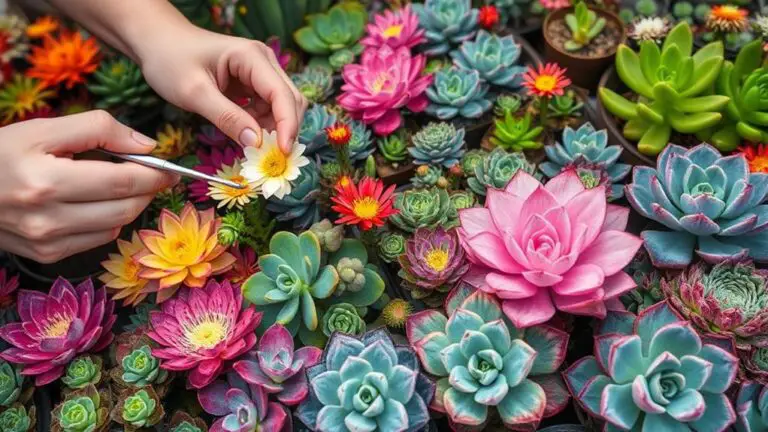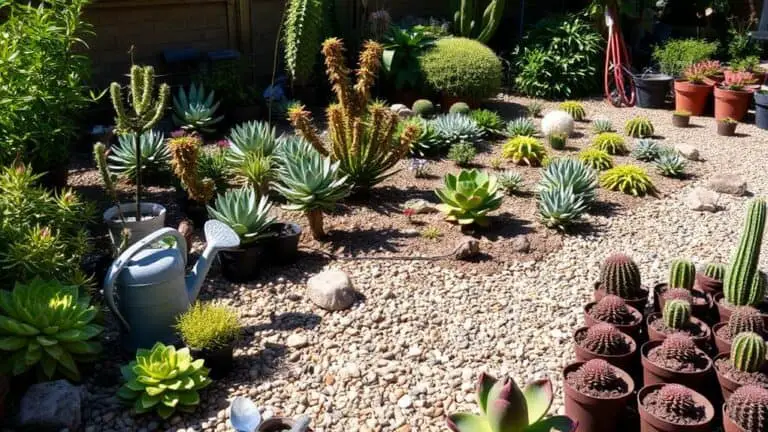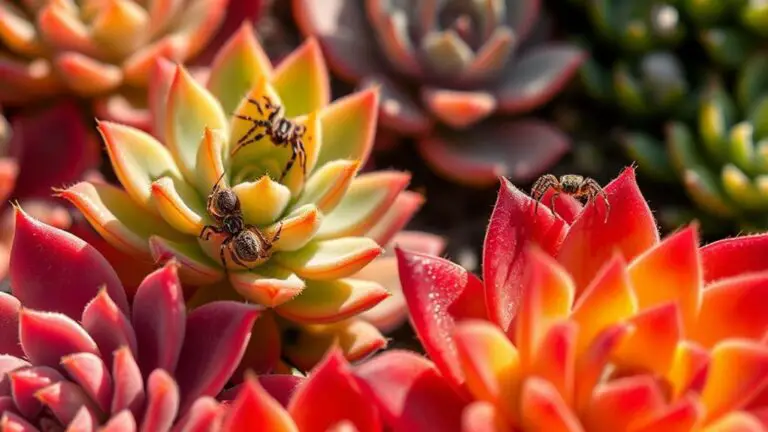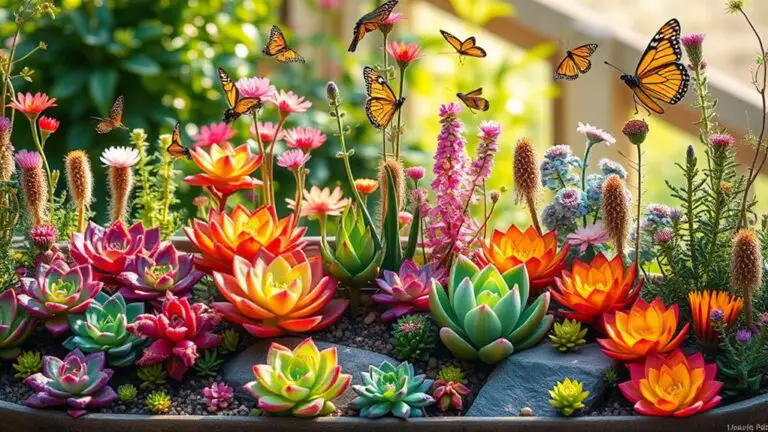7 Steps to Use Diatomaceous Earth on Succulents
If you're looking to protect your succulents from pests naturally, diatomaceous earth (DE) is a great solution, but where do you start? First, you'll need to understand what DE is and why food-grade DE is vital for safety. Once you've got the right type, preparing your succulents properly is fundamental before applying DE. But how exactly do you go about this preparation? And what's the best method for applying DE to guarantee it's effective? Let's explore these steps to make certain your succulents thrive pest-free.
Understand Diatomaceous Earth
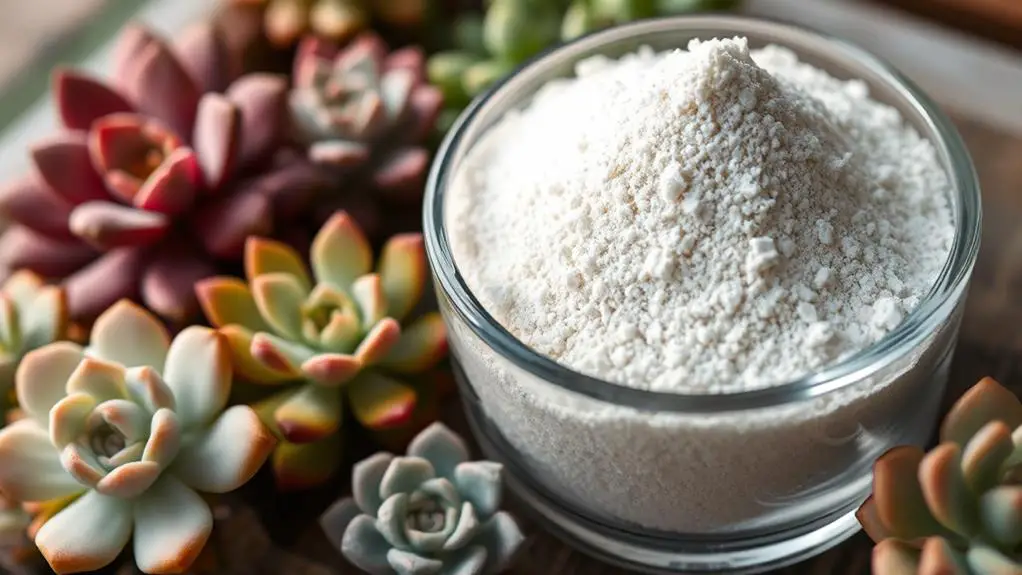
Understanding Diatomaceous Earth is important if you want to use it effectively on your succulents. DE is a fine powder made from the fossilized remains of diatoms, which are tiny aquatic algae. It's mainly composed of silica, making it abrasive to insects.
When you apply diatomaceous earth to your succulents, it acts as a natural desiccant. This means it dehydrates soft-bodied pests like aphids and spider mites by causing tiny cuts on their exoskeletons.
Using food-grade diatomaceous earth is essential for safety and effectiveness. Unlike filter grade DE, food-grade DE is non-toxic to humans, pets, and plants, making it a safe alternative to chemical pesticides. When you use DE, you can confidently protect your succulents without harming your environment.
Besides pest control, DE improves soil texture and drainage. Mixing it into your potting soil promotes healthier root development, which is important for your succulents' well-being.
Choose the Right Grade
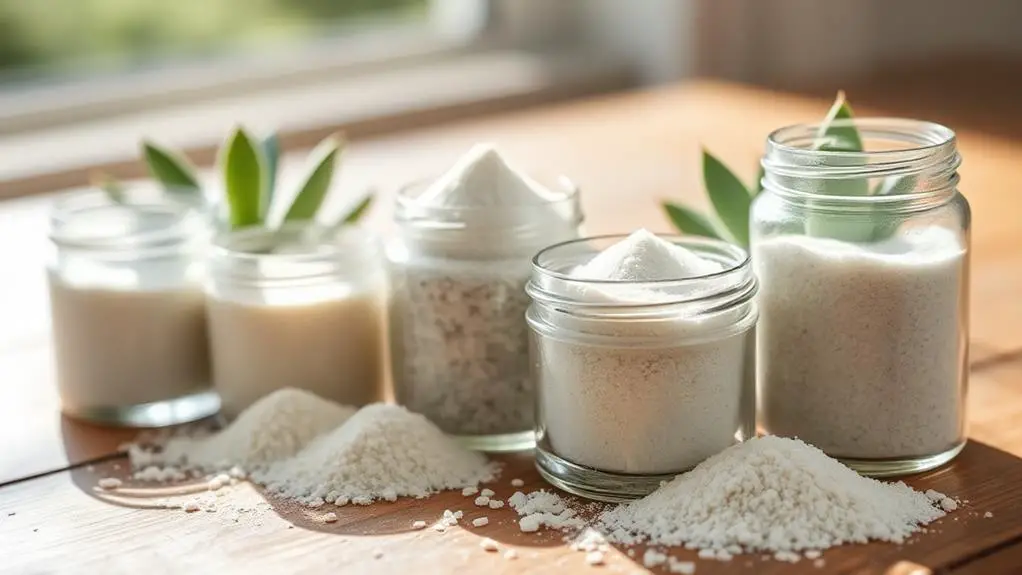
Choosing the right grade of diatomaceous earth (DE) is essential for safely protecting your succulents. You'll want to use food-grade diatomaceous earth. It's safe for both your plants and pets, unlike filter grade DE, which can be toxic.
Food-grade DE contains no harmful additives, making it perfect for organic gardening practices.
When selecting your DE, make certain it's free from contaminants and sourced from reputable suppliers. This guarantees that you're getting a high-quality product.
Look for packaging that clearly states "food grade" to avoid any mix-up with industrial-grade products. This simple step in your plant care routine can make a big difference.
You might also want to evaluate DE products that include applicators. These can help you apply DE more precisely, reducing waste and making it more effective.
Plus, using an applicator makes it easier to target specific areas where pests might hide without harming beneficial insects.
Prepare the Succulents
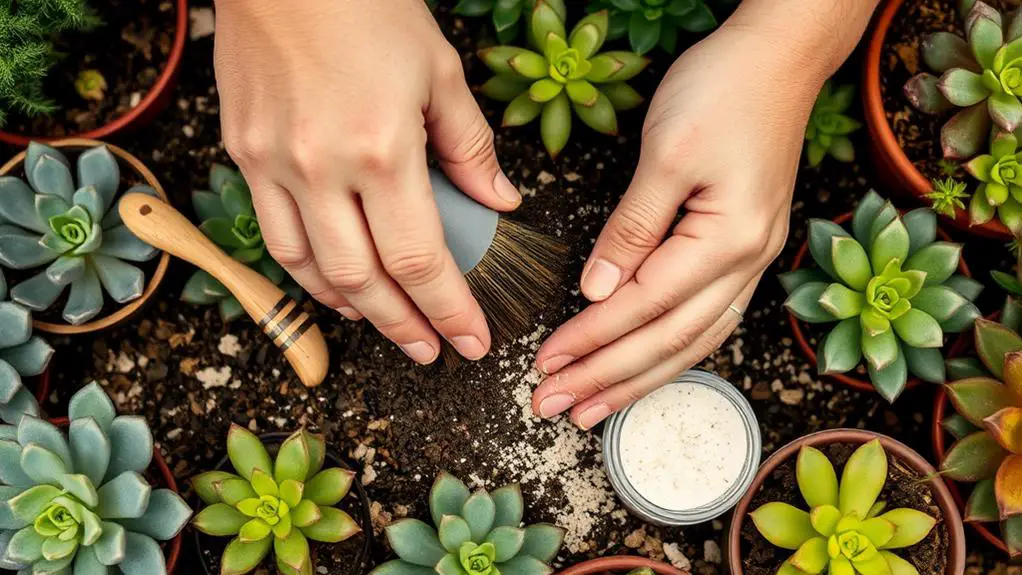
After selecting the right grade of diatomaceous earth, it's time to prepare your succulents for treatment. First, make certain the soil around your succulents is completely dry. This step is essential because it prevents the diatomaceous earth (DE) from clumping and guarantees it adheres properly. If the soil is moist, consider watering your succulents a day or two before applying DE. This allows the soil to dry out and assures the best results.
Next, inspect each succulent for any visible pests, like aphids or gnats. Identifying these areas helps you know where to focus your DE application. Carefully remove any dead or decaying leaves from the base of the plants. This reduces hiding spots for pests and improves air circulation, which is beneficial for your succulents' health.
Choose a well-ventilated area for the application process. This protects both you and the plants from inhaling dust during treatment. Applying diatomaceous earth can be messy, but taking these preparatory steps will make it more effective.
Remember to use food-grade DE to guarantee safety for your plants. By following these steps, you'll be well on your way to a pest-free succulent garden.
Apply as a Powder

To apply diatomaceous earth (DE) as a powder, start by making sure that the soil around your succulents is completely dry. This prevents clumping and makes the DE more effective against pests.
Once the soil is dry, follow these steps:
- Sprinkle a thin layer: Lightly sprinkle a thin layer of DE around the base of your succulents. Focus on both the soil and the stems to create a barrier against soft-bodied insects.
- Target hidden pests: Carefully apply DE to cover the undersides of leaves and any affected areas. Pests often hide in these locations, so it's important to reach them.
- Reapply regularly: Reapply DE every 2-3 weeks or after heavy watering or rain. This helps maintain its pest control properties and prevents moisture retention on leaves.
- Use food-grade DE: Always use food-grade diatomaceous earth to guarantee it's safe for your plants. Avoid filter-grade products, which may contain harmful additives.
Use in a Spray

Creating a diatomaceous earth spray offers a convenient way to combat pests on your succulents without the mess of powder application. To make this spray, mix one tablespoon of food-grade diatomaceous earth with one quart of water in a spray bottle. This mixture guarantees an even distribution on your succulents.
Remember to shake the spray bottle well before each use. This keeps the diatomaceous earth suspended in the water for effective application.
When you're ready to apply, focus on the undersides of leaves and stems. Pests often hide in these spots, so thorough coverage is essential.
Spraying in the morning or late afternoon is best. Cooler temperatures during these times help prevent rapid evaporation, allowing the spray to adhere better to the plant surfaces.
Apply the diatomaceous earth spray every 2-3 weeks or after a rain. Regular reapplication maintains its effectiveness against pests. This prevents moisture retention that could lead to fungal issues.
Reapply as Needed
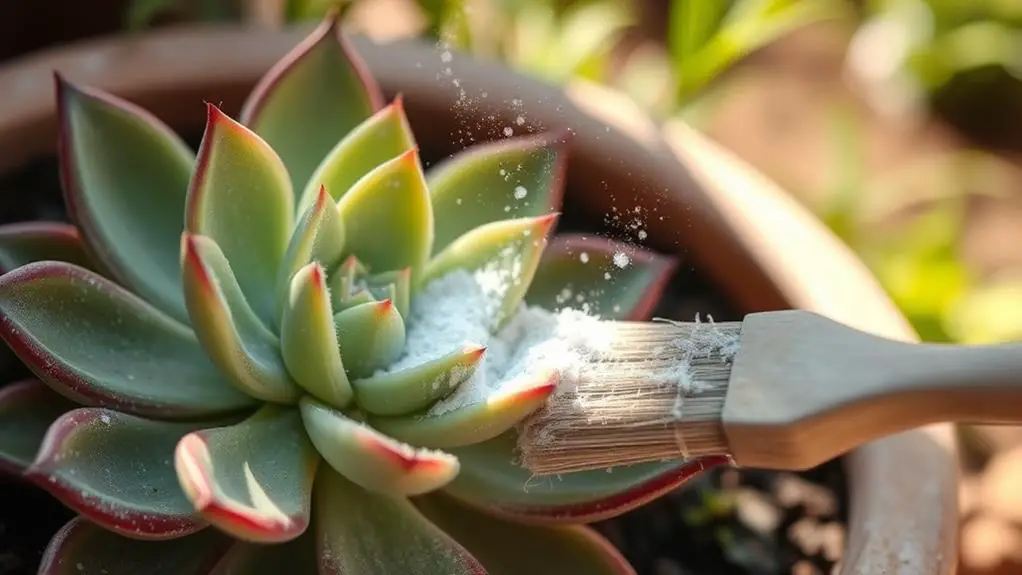
Maintaining the effectiveness of your diatomaceous earth spray requires periodic reapplication. You need to stay vigilant to keep those pesky pests at bay. Here's how you can guarantee your succulents stay protected:
- Reapply every 2-3 weeks: To maintain its effectiveness, make it a habit to reapply diatomaceous earth every two to three weeks. This regular schedule helps keep the pests under control.
- After rain or watering: DE loses its effectiveness when it gets wet. Rain or watering can cause it to clump, making it less effective. Always reapply DE after any moisture event to keep that protective barrier in place.
- Monitor and adjust frequency: Keep an eye on your succulents. If you notice any pests, it may be time to reapply even sooner. Your plants will thank you for the extra attention.
- After soil disturbances: Disturbances like repotting or heavy pruning can disrupt the DE layer. Make sure to reapply DE after such activities to guarantee continuous protection.
Follow Safety Precautions

Wondering how to safely apply diatomaceous earth to your succulents? Let's make sure you're doing it right while keeping everyone safe.
First, always wear protective gear. This includes a mask, gloves, long sleeves, and goggles. Diatomaceous earth can irritate your skin and lungs, so proper protection is key.
Next, work in a well-ventilated area or outdoors. Inhaling the fine powder can cause respiratory issues, and good airflow will help minimize dust exposure.
It's crucial to keep children and pets away from the treated areas. The fine powder can be harmful if ingested or inhaled by your little ones or furry friends.
Avoid direct contact with your eyes and skin. Diatomaceous earth is abrasive and can cause irritation or dryness. If you do get some on you, wash it off promptly with water.
Frequently Asked Questions
How to Use Diatomaceous Earth for Succulents?
To use diatomaceous earth on succulents, wait for dry soil, lightly sprinkle DE around the base and soil surface, use a dusting spray for hard-to-reach areas, and reapply every 2-3 weeks or after rain.
How Do You Apply Diatomaceous Earth Properly?
To apply diatomaceous earth properly, make sure the soil is dry. Sprinkle it on the soil surface, plant, and undersides of leaves. Mix 20% DE into the soil and reapply every 2-3 weeks or after rain.
Do You Water After Applying Diatomaceous Earth?
No, you shouldn't water immediately after applying diatomaceous earth. Wait at least 24 hours to guarantee it effectively creates a barrier against pests. Watering too soon can wash it away, reducing its effectiveness.
Can You Sprinkle Diatomaceous Earth on Plant Leaves?
Yes, you can sprinkle diatomaceous earth on plant leaves. Confirm the leaves are dry to avoid clumping. Lightly dust all surfaces, including undersides, for effective pest control. Monitor your plants to avoid over-application.
Conclusion
You've got this! By understanding diatomaceous earth and choosing the right grade, you're already on the path to healthy succulents. Preparing your plants and applying DE as a powder or spray can make a big difference in pest control. Remember to reapply it every few weeks and follow safety precautions. With these steps, your succulents will thrive. Keep up the great work, and enjoy your beautiful, pest-free plants!


